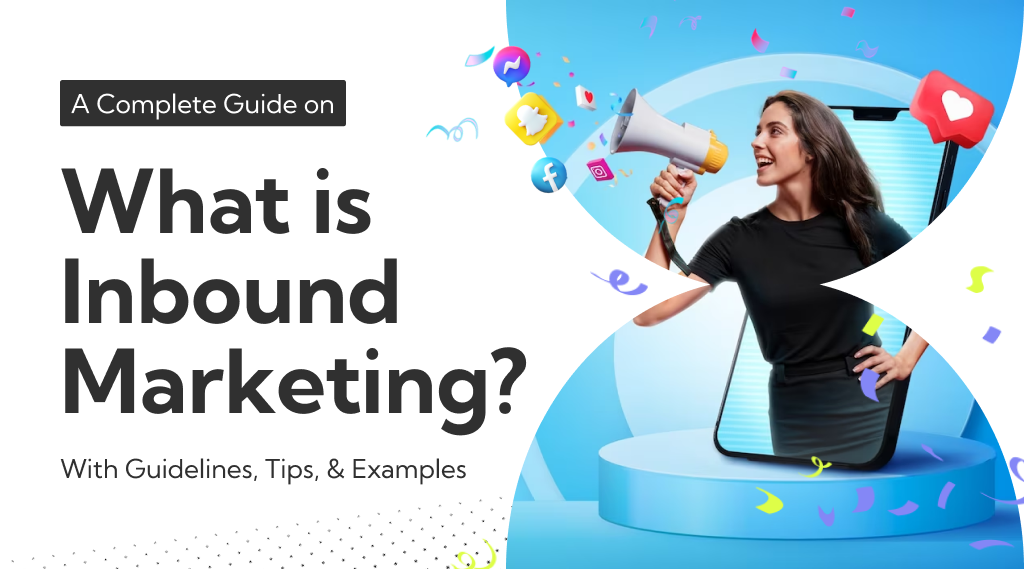Introduction
In today’s digital age, traditional marketing tactics are losing their edge, and consumers are becoming increasingly adept at tuning out interruptive advertisements. This shift has led to the rise of inbound marketing, a powerful strategy that focuses on attracting, engaging, and delighting customers by providing them with valuable content and experiences.
In this comprehensive guide, we will delve deep into the world of inbound marketing, exploring what it is, how it differs from outbound marketing, and offering practical tips and examples to help you master this game-changing approach.
What Is Inbound Marketing In Digital Marketing?
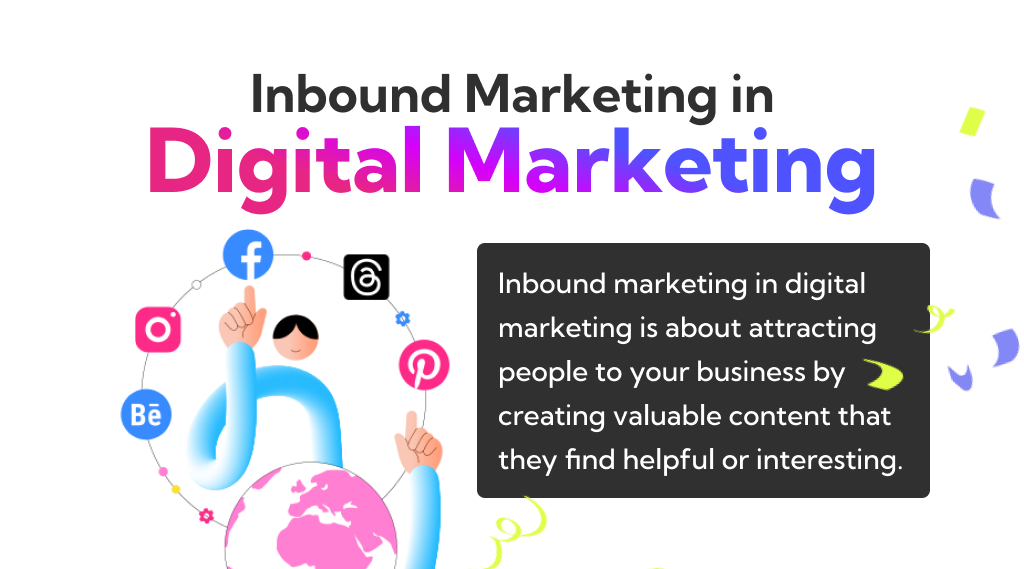
Inbound marketing is a holistic approach to digital marketing that revolves around the idea of earning the attention of potential customers rather than buying it. It involves creating and sharing valuable, relevant content that addresses the specific needs and challenges of your target audience.
This content can take various forms, including blog posts, videos, social media posts, ebooks, webinars, and more.
What is Inbound Marketing and Outbound Marketing?
Inbound marketing and outbound marketing are two fundamentally different approaches to reaching your audience.
Outbound marketing, often referred to as traditional or interruptive marketing, involves pushing promotional messages to a wide audience, regardless of whether they are interested or not. Examples include TV and radio ads, cold calls, and direct mail. These methods are often expensive and less effective in today’s ad-saturated world.
On the other hand, inbound marketing is about drawing your audience in by providing them with content and experiences that align with their interests and needs. It’s permission-based and focuses on building meaningful relationships with prospects and customers. This approach is more cost-effective and tends to yield higher-quality leads and conversions.
Inbound Marketing Vs Outbound Marketing
The primary distinction between inbound and outbound marketing lies in their approaches to audience engagement and customer acquisition.
In inbound marketing, the emphasis is on creating valuable content that educates, informs, and entertains the audience. It’s about being found when potential customers are actively seeking solutions to their problems. This approach fosters trust and credibility, making it easier to convert leads into customers.
Outbound marketing, in contrast, involves reaching out to a broad audience, often with interruptive messages. This method relies on interruption and persuasion to generate interest, which can lead to resistance and annoyance from the audience.
Inbound Marketing vs. Outbound Marketing: Examples and Contrasts
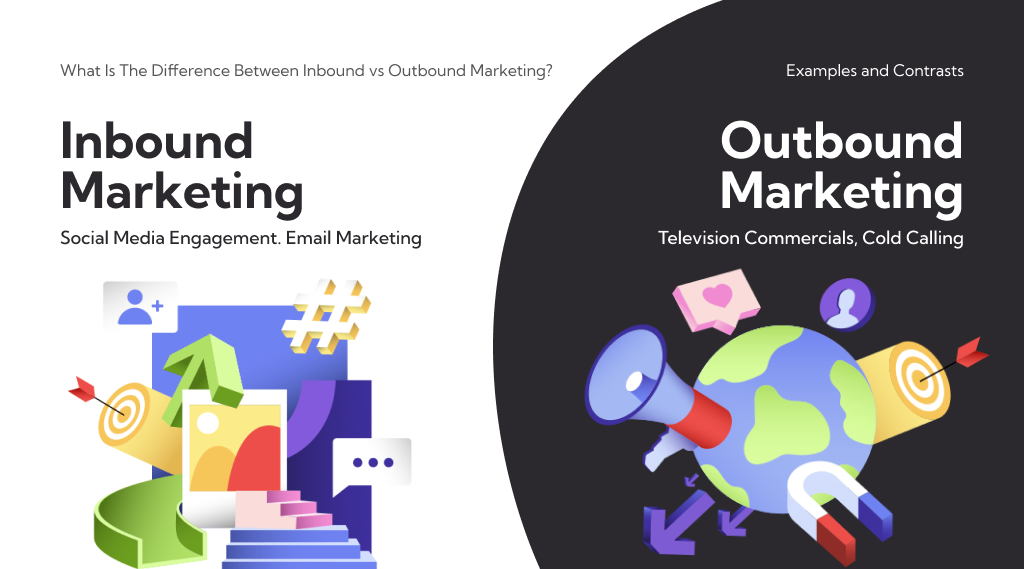
To truly understand the differences between inbound and outbound marketing, let’s explore real-world examples that highlight the contrast in their approaches, strategies, and outcomes.
Outbound Marketing Examples:
1. Television Commercials: Traditional TV commercials are classic examples of outbound marketing. They interrupt your favorite shows with messages about products or services you may or may not be interested in. For instance, during the Super Bowl, you’ll see a barrage of commercials from various brands trying to capture viewers’ attention.
Contrast: Inbound marketing would involve creating informative, entertaining content related to the Super Bowl, like articles about the history of the event or videos analyzing game strategies. This content would attract football enthusiasts naturally.
2. Cold Calling: Sales representatives making unsolicited phone calls to potential customers is another outbound marketing method. They often provide scripted sales pitches, hoping to persuade people to buy.
Contrast: Inbound marketing would instead focus on creating valuable resources, such as guides on solving common industry problems or hosting webinars on relevant topics. People interested in those topics would willingly provide their contact information to access these resources, turning them into leads.
Inbound Marketing Examples:
1. Blogging for SEO: A company that sells fitness equipment might maintain a blog with articles like “Top 10 Exercises for Building Muscle” or “How to Choose the Right Treadmill.” These articles are optimized for search engines, so when individuals search for fitness tips or equipment recommendations, they find this content.
Contrast: In outbound marketing, the fitness company might purchase ad space in a fitness magazine, hoping that readers will see the ad and make a purchase. This approach doesn’t address the specific needs of those actively seeking fitness information.
2. Email Marketing with Personalization: Sending personalized emails based on a recipient’s behavior and preferences is a powerful inbound marketing tactic. For instance, an online clothing retailer might send product recommendations based on the customer’s previous purchases or browsing history.
Contrast: An outbound marketing strategy could involve sending mass emails to a purchased list of email addresses, without personalization or relevance. Such emails are often considered spam and are unlikely to yield positive results.
3. Social Media Engagement: Inbound marketing on social media involves creating engaging content and fostering meaningful interactions. For example, a travel agency might run a social media campaign sharing user-generated vacation photos and stories, encouraging followers to share their own experiences.
Contrast: Outbound marketing on social media would focus on paid advertisements that appear in users’ feeds, irrespective of their interests or engagement with the brand. These ads are often seen as intrusive and may not resonate with the audience.
In conclusion, outbound marketing relies on interruptive, one-way communication to reach potential customers, while inbound marketing centers on attracting and engaging an audience through valuable, relevant content. Inbound marketing builds trust, drives organic interest, and creates lasting customer relationships, making it a more effective and customer-centric approach in today’s digital landscape.
Inbound Marketing Vs Content Marketing
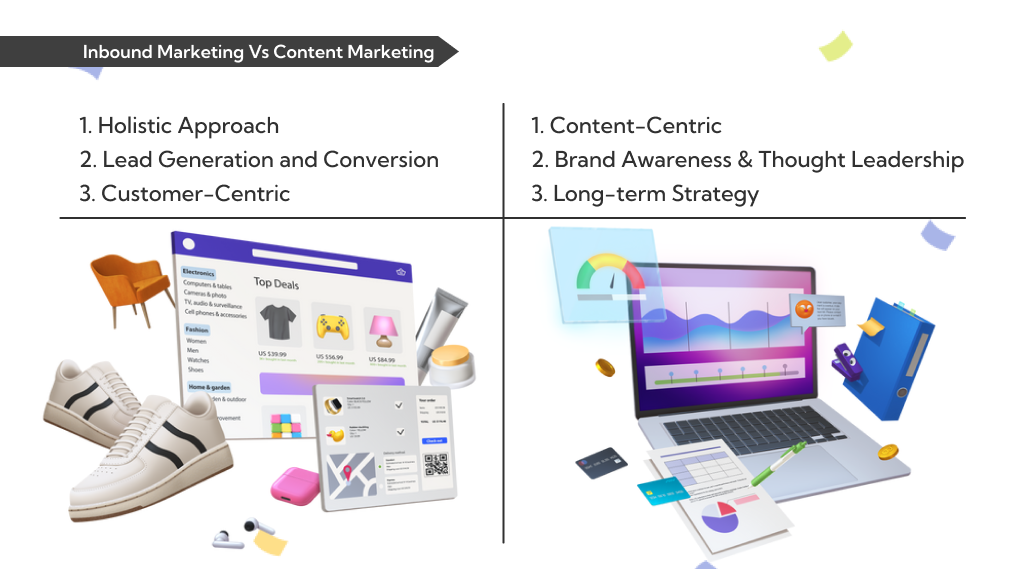
Inbound marketing and content marketing are closely related concepts within the broader digital marketing landscape, but they have distinct purposes and scopes.
1. Content Marketing:
Content marketing is a subset of inbound marketing. It focuses specifically on creating and distributing valuable, relevant, and consistent content to attract and engage a target audience. Content can take various forms, including blog posts, videos, infographics, ebooks, podcasts, and more.
Key Characteristics of Content Marketing:
- Content-Centric: Content marketing places a strong emphasis on creating high-quality, informative, and engaging content. The primary goal is to provide value to the audience through educational or entertaining material.
- Brand Awareness and Thought Leadership: Content marketing helps establish a brand’s authority and thought leadership within its industry. It positions the brand as a valuable source of information and expertise.
- Long-term Strategy: Content marketing often involves the creation of evergreen content that remains relevant over time. It aims to build a lasting content library that continues to attract and engage audiences.
2. Inbound Marketing:
Inbound marketing is a comprehensive strategy that encompasses various tactics, including content marketing. It goes beyond content creation to include elements like SEO, social media, email marketing, lead generation, and customer relationship management. Inbound marketing’s ultimate goal is to attract, convert, close, and delight customers by providing a seamless and valuable experience throughout their journey.
Key Characteristics of Inbound Marketing:
- Holistic Approach: Inbound marketing is a multi-faceted strategy that integrates content marketing with other tactics to create a cohesive customer experience. It covers the entire customer lifecycle.
- Lead Generation and Conversion: While content marketing focuses on creating content, inbound marketing aims to turn visitors into leads and, eventually, into customers. It involves lead nurturing and sales funnel optimization.
- Customer-Centric: Inbound marketing revolves around understanding the needs and preferences of the target audience. It utilizes data and personalization to deliver the right message at the right time.
In summary, content marketing is a vital component of inbound marketing. It involves creating valuable content to attract and engage an audience, primarily focusing on building brand awareness and thought leadership.
In contrast, inbound marketing is a broader strategy that encompasses content marketing and extends to various tactics aimed at the entire customer journey, from initial awareness to post-purchase delight. Inbound marketing is more customer-centric, data-driven, and conversion-focused, making it a comprehensive approach to achieving sustainable growth in the digital era.
The 5 Principles of Inbound Marketing
Inbound marketing is not just a strategy; it’s a philosophy that prioritizes customer-centric approaches to engage, convert, and delight audiences. These principles guide the foundation of effective inbound marketing strategies:
1. Attract: At the heart of inbound marketing is the principle of attracting the right audience. To do this, you must create high-quality, relevant, and valuable content that speaks to your target audience’s needs and interests. This content could be blog posts, videos, social media updates, or podcasts, all optimized for search engines (SEO) to increase visibility.
2. Convert: Once you’ve attracted visitors to your digital platforms, the next principle is to convert them into leads. Offer something of value, like ebooks, webinars, or newsletters, in exchange for their contact information. Effective landing pages and forms are essential here.
3. Close: Inbound marketing doesn’t stop at lead generation; it’s about turning those leads into customers. To close the deal, employ marketing automation, lead nurturing, and personalized communication to guide leads through the sales funnel. Understand their pain points and offer tailored solutions.
4. Delight: Beyond the purchase, inbound marketing aims to delight customers. Offer excellent customer support, personalized recommendations, and exclusive content to create a positive post-purchase experience. Happy customers become promoters who can attract new leads.
5. Analyze and Improve: Continual analysis and improvement are central to inbound marketing. Use data and analytics to understand what’s working and what’s not. Adjust your strategies, content, and tactics accordingly to optimize performance and achieve better results over time.
The 4 Elements Of Inbound Marketing
Inbound marketing comprises four interconnected elements, each playing a crucial role in achieving success:
1. Content: Content creation is the core of inbound marketing. This includes blog posts, videos, infographics, ebooks, webinars, and more. Content should be relevant, informative, and engaging, addressing the pain points and interests of your target audience.
2. SEO:

SEO is essential to ensure that your content is discoverable by your target audience. It involves optimizing your website and content to rank higher in search engine results, driving organic traffic.
3. Social Media: Social media platforms are vital for distributing and promoting your content. Engage with your audience, share valuable content, and build a community around your brand to attract and retain followers.
4. Marketing Automation: Marketing automation tools streamline the process of nurturing leads and delivering personalized content. They enable you to send the right message to the right person at the right time, enhancing efficiency and effectiveness.
These four elements work together cohesively to implement the principles of inbound marketing. By creating valuable content, optimizing it for search engines, promoting it on social media, and using marketing automation to guide leads through the sales funnel, you can successfully attract, convert, close, and delight your audience, building lasting customer relationships and driving business growth.
Why is Inbound Marketing Important?
Inbound marketing is of paramount importance in today’s digital landscape for several compelling reasons:
1. Customer-Centric Approach: Inbound marketing prioritizes the needs and preferences of the customer. By creating valuable, relevant content that addresses their pain points, it builds trust and fosters meaningful relationships. This customer-centric approach resonates with modern consumers who are increasingly averse to traditional, interruptive marketing tactics.
2. Cost-Effective: Inbound marketing is often more cost-effective than outbound methods. Creating and distributing digital content is considerably less expensive than running large-scale advertising campaigns. Moreover, inbound strategies yield higher-quality leads and conversions, maximizing the return on investment.
3. Long-Term Sustainability: Inbound marketing focuses on creating evergreen content that continues to attract and engage audiences over time. This sustainable approach builds a strong online presence, resulting in a consistent flow of organic traffic and lead generation.
4. Enhanced Targeting: Inbound marketing leverages data and analytics to understand customer behavior and preferences. This allows for precise targeting, ensuring that content reaches the right audience at the right time, increasing the likelihood of conversions.
5. Brand Authority and Thought Leadership: By consistently delivering valuable content, inbound marketing positions brands as experts in their respective industries. This establishes authority and thought leadership, making it more likely that consumers will turn to your brand when seeking solutions or making purchasing decisions.
In summary, inbound marketing’s customer-centric, cost-effective, and sustainable nature, coupled with its ability to establish brand authority and enhance targeting, makes it a crucial strategy for businesses seeking to thrive in the digital age. It not only attracts and converts customers but also nurtures long-lasting relationships, driving growth and profitability.
Inbound Marketing Examples
1. HubSpot: HubSpot, a leading inbound marketing and sales platform, practices what it preaches. Their blog offers a wealth of informative articles, ebooks, and webinars on marketing, sales, and customer service, attracting and converting countless visitors into customers.
2. Coca-Cola Journey: Coca-Cola’s online magazine, “Coca-Cola Journey,” is a prime example of content-driven inbound marketing. It features engaging stories, videos, and articles that connect with its global audience, reinforcing the brand’s image and fostering customer loyalty.
3. Buffer’s Social Media Blog: Buffer, a social media management tool, maintains an informative blog on social media marketing. They provide valuable content on social media strategies, analytics, and trends, attracting professionals seeking to improve their social media presence and efficiency.
4. Moz’s Whiteboard Friday: Moz, an SEO software and service company, hosts “Whiteboard Friday,” a weekly video series. They delve into various SEO topics, providing expert insights that attract a dedicated audience of digital marketers and SEO enthusiasts.
5. Dollar Shave Club’s Viral Videos: Dollar Shave Club disrupted the grooming industry with witty and entertaining viral videos. These videos not only attracted millions of viewers but also effectively conveyed their unique value proposition, ultimately converting viewers into subscribers.
What is an Inbound Marketing Strategy?
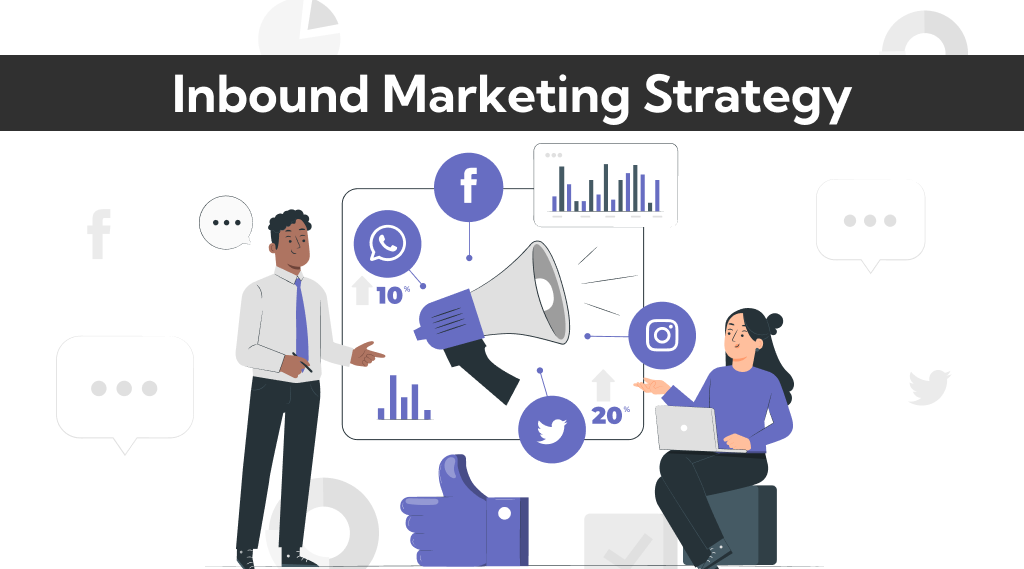
An inbound marketing strategy is a structured approach to engaging and converting potential customers by providing them with valuable content and experiences. It revolves around the idea of attracting, engaging, and delighting your target audience rather than interrupting them with traditional advertising. Here are the key components of an inbound marketing strategy:
1. Buyer Persona Development: Creating detailed profiles of your ideal customers to understand their needs and preferences.
2. Content Creation: Developing valuable and relevant content, such as blog posts, videos, ebooks, and webinars, to address your audience’s pain points.
3. SEO (Search Engine Optimization): Optimizing your content and website to rank higher in search engine results, making it easier for potential customers to find you.
4. Social Media: Leveraging social media platforms to promote your content, engage with your audience, and build brand awareness.
5. Email Marketing: Nurturing leads through personalized email communication, guiding them through the buyer’s journey.
6. Lead Generation: Using strategies like gated content to turn website visitors into leads.
7. Marketing Automation: Implementing tools and workflows to automate lead nurturing, segmentation, and content delivery.
8. CRM (Customer Relationship Management): Managing customer data to provide personalized experiences and track interactions.
9. Analytics and Data Analysis: Continuously monitoring and analyzing data to measure the effectiveness of your strategies and make data-driven improvements.
What Do Inbound Marketers Do?
Inbound marketers play a multifaceted role in executing an inbound marketing strategy effectively. They are responsible for various tasks and activities aimed at attracting, engaging, and converting leads into customers. Inbound marketers:
Inbound marketers create valuable and relevant content that resonates with the target audience. This involves writing blog posts, creating videos, designing infographics, and developing other types of content that address the audience’s pain points and interests.
- Optimize Content for SEO: They ensure that all content is optimized for search engines, making it more discoverable by potential customers who use search engines to find information related to your products or services.
- Leverage Social Media: Inbound marketers use social media platforms to share content, engage with the audience, and build brand awareness. They create and curate content tailored to each platform and its audience.
- Nurture Leads: Inbound marketers employ email marketing campaigns and automation to nurture leads through personalized communication. They send relevant content and information based on where leads are in the buying process.
- Analyze and Optimize: They continuously monitor the performance of content and campaigns, using data and analytics to make informed decisions. Inbound marketers identify what works and what needs improvement, adjusting strategies accordingly.
- Manage CRM Systems: Inbound marketers use Customer Relationship Management (CRM) systems to organize and track leads and customer interactions. This helps provide a more personalized experience and streamline communication.
- Stay Updated: They stay up-to-date with industry trends, algorithm changes, and emerging technologies to adapt their strategies and tactics accordingly.
In summary, inbound marketers are responsible for creating and promoting content, optimizing for search engines, engaging with the audience on social media, nurturing leads, analyzing performance, managing customer data, and staying current with industry developments.
Their holistic approach contributes to the success of an inbound marketing strategy in attracting, converting, and delighting customers.
What Is Inbound Sales?
Inbound sales is a customer-centric approach to selling that aligns with the principles of inbound marketing. It focuses on building meaningful relationships with potential customers by providing personalized and relevant solutions to their needs. Unlike traditional sales methods that rely heavily on cold calling and pushing products or services, inbound sales prioritizes understanding the buyer’s journey, engaging with prospects at the right time, and delivering value throughout the sales process.
Inbound sales professionals act as consultants and problem solvers, guiding prospects toward the best solutions for their specific challenges while fostering trust and loyalty.
The Four Stages of Inbound Sales:
1. Identify and Connect:
- Research and understand the prospect’s needs, pain points, and goals.
- Use social media, email, or other communication channels to connect with prospects.
- Provide valuable insights and establish rapport, emphasizing a consultative approach.
2. Explore and Advise:
- Engage in meaningful conversations with prospects to uncover their challenges and objectives.
- Ask open-ended questions to gain a deeper understanding of their specific needs.
- Tailor recommendations and solutions that align with the prospect’s unique situation.
3. Collaborate and Present:
- Collaborate with the prospect to co-create solutions or strategies that address their pain points.
- Present relevant content, resources, or product demonstrations to illustrate how your offering can solve their problems.
- Emphasize the value and benefits of your solution rather than focusing solely on the product or service features.
4. Close and Nurture:
- Once the prospect is ready to make a decision, guide them through the purchase process.
- Ensure a seamless transition from prospect to customer by providing exceptional support and onboarding.
- Continue to nurture the customer relationship post-purchase by delivering ongoing value, addressing any concerns, and seeking opportunities for upselling or cross-selling when appropriate.
Inbound sales is about building trust, fostering collaboration, and helping prospects make informed decisions that benefit them. It’s a customer-focused approach that aligns with the modern buyer’s preferences for personalized and consultative interactions, ultimately leading to more satisfied customers and stronger long-term relationships.
What Is Sales Enablement?
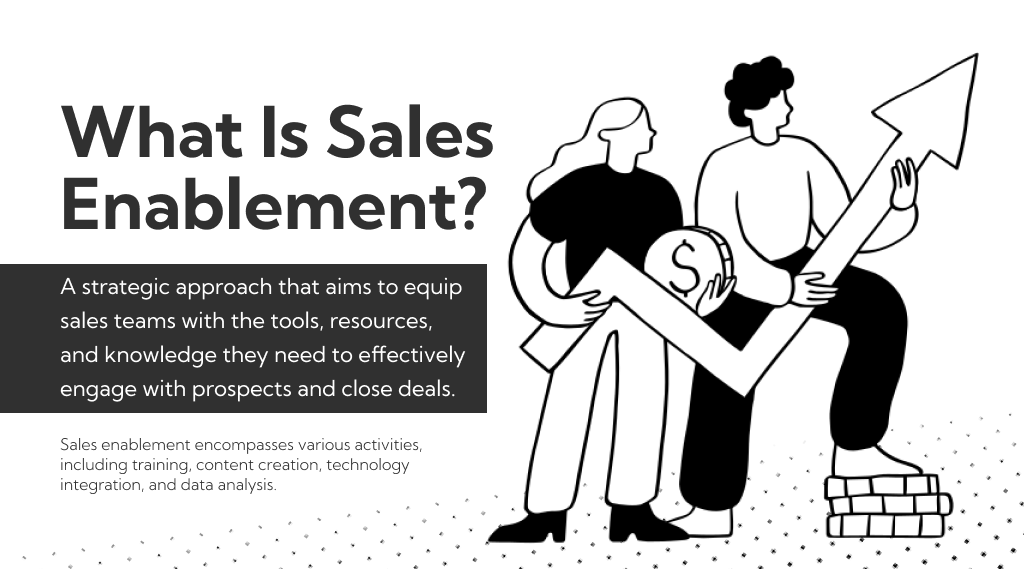
Sales enablement is a strategic approach that aims to equip sales teams with the tools, resources, and knowledge they need to effectively engage with prospects and close deals. It’s a multifaceted strategy that aligns marketing and sales efforts to improve the efficiency and effectiveness of the sales process. Sales enablement encompasses various activities, including training, content creation, technology integration, and data analysis.
The ultimate goal of sales enablement is to empower salespeople to have more meaningful, informed, and productive interactions with potential customers, leading to higher conversion rates and increased revenue.
Sales enablement involves:
1. Content Creation: Developing sales collateral, presentations, and resources that address common customer questions and objections, making it easier for salespeople to communicate value.
2. Training and Development: Providing ongoing training to ensure sales teams are up-to-date on product knowledge, industry trends, and effective sales techniques.
3. Technology Integration: Implementing tools and technologies like CRM systems, sales automation, and analytics platforms to streamline processes and provide insights into prospect behavior.
4. Sales Playbooks: Creating documented strategies and processes that guide sales teams in handling different types of leads and situations.
5. Feedback Loops: Establishing mechanisms for sales teams to provide feedback to marketing and product development, facilitating continuous improvement.
How Setting Up a Proper Inbound Marketing Strategy Can Help You Scale Your Business Faster
A well-executed inbound marketing strategy can be a catalyst for rapid business growth for several reasons:
1. Scalable Lead Generation: Inbound marketing focuses on creating valuable content that attracts a steady stream of organic leads. As your content library grows, so does your lead generation potential, allowing you to scale without linearly increasing marketing costs.
2. Qualified Leads: Inbound marketing targets prospects who are actively seeking solutions to their problems, resulting in higher-quality leads that are more likely to convert into customers.
3. Efficient Marketing Spend: Inbound marketing is cost-effective compared to outbound methods. You invest in creating content once, and it continues to attract and engage prospects over time, providing a higher return on investment.
4. Customer-Centric Approach: Inbound marketing prioritizes understanding and addressing the needs of your target audience, which fosters trust and loyalty. Satisfied customers become brand advocates, contributing to organic growth through referrals and word-of-mouth.
5. Data-Driven Optimization: Inbound marketing relies on data and analytics to measure performance and make data-driven improvements. This iterative process allows you to refine your strategies and tactics continuously.
6. Global Reach: In the digital age, inbound marketing can help you reach a global audience, enabling expansion into new markets more efficiently than traditional methods.
By establishing a proper inbound marketing strategy, businesses can attract, convert, and retain customers at scale while optimizing their marketing efforts. It’s a customer-centric, cost-effective, and data-driven approach that accelerates business growth and helps companies scale faster in today’s competitive landscape.
Conclusion
In today’s dynamic business landscape, scaling your SaaS company requires innovative strategies that resonate with your target audience. We’ve explored the power of inbound marketing and how it can be a game-changer for your growth. By adopting a customer-centric approach, creating valuable content, and leveraging data-driven insights, you can transform the way you attract, engage, and retain customers.
If you’re ready to take your SaaS marketing to the next level, SaaSMarketing.in is your trusted partner. They specialize in SaaS marketing and offer expert guidance to help you navigate the intricacies of this competitive industry. Whether you’re looking to optimize your lead generation, improve conversion rates, or enhance customer retention, their team of professionals can provide tailored solutions to meet your unique needs.
Don’t miss the opportunity to scale your SaaS business faster and more efficiently. Visit Saasmarketing.in today to explore their comprehensive services and resources. Your journey to SaaS marketing success begins here.

